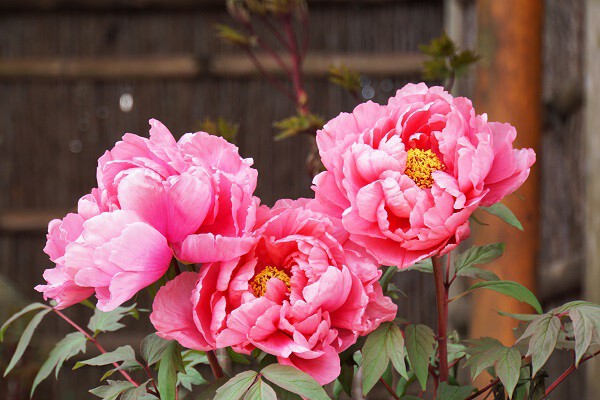These fluffy, layered flowers are beloved by gardeners of all skill levels. Here, learn how to care for your newly-planted peonies.
While the beauty and elegance of peonies could seem intimidating to a novice gardener, caring for them is actually far simpler than you'd think. "Peonies are easy!" says Kathleen Gagan, owner of Peony's Envy in Bernardsville, New Jersey. "They're disease-resistant, so they don't need pesticides, and once established, they don't need a lot of water," she says. The key is patience—peonies can take a few years to settle in once planted, but they'll go on to live for hundreds of years if you care for them well.

Growing Tips
Peonies grow from zones three to eight, and while herbaceous peonies crave lots of sunshine, tree peonies like dappled shade. The best time to plant is generally the first week of April. When selecting herbaceous peony roots to plant, look for healthy, fleshy firm roots (they should feel like firm carrots) and abundant eyes. As you plant, it's important to position the eyes of the root at the right depth. This varies by zone—in general, you'll want the eyes closer to the surface the warmer your climate. You can also purchase a container-grown plant, which will generally be at least three years old and can be planted right away, but fall or spring, when temperatures are mild, is best.
Paeonia suffruticosa, known as tree peonies, are difficult to find, but if you can get them, they're worth the investment. To plant, find where the root and stem meet and plant one inch deeper. The trees can grow seven to eight feet tall over their lifetime and can live hundreds of years. One of the most revered types is the Chinese tree peony. It is not, as its name implies, a tree, but rather a sparsely branched deciduous shrub with dark-green leaves and unimaginably large (and often fragrant) white, pink, red, or purple flowers. Kasha and David Furman, of Cricket Hill Garden in Thomaston, Connecticut, have worked for 10 years establishing relationships with growers in China and importing these beautiful plants. Tree peonies planted in spring may not have enough time to develop the roots they need to support a new flush of growth, so you should plant them in fall. Once they're planted, be sure to water and deadhead your tree peonies regularly.
How to Care for Peonies
Peonies can thrive for decades, and because they hate to be disturbed, you really need to pick a spot where they can remain for years to come. Both herbaceous and tree peonies can tolerate full sun, but the flower will last longer if there is a bit of shade each day. Growing peonies is not difficult, but the Furmans do recommend that you plant them in moist but well-drained soil and in an area that's free of competing plant roots. Because peony flowers are so heavy, it's important to support or stake them so that they don't fall over. Peony cages or rings, or even a homemade system with stakes and rope, will do the job.
How to Store Peonies
Peonies make great cut flowers, and they're easy to store in your fridge for later use if you're dealing with an embarassment of riches all at once, as is common with peonies. Their short bloom time means the vast majority of your blooms will be ready to cut and display at once. For flowers you plan to cut and enjoy right away, cut buds when they're still somewhat closed but soft. They should feel almost like a marshmallow. To get a little more life out of your remaining buds, simply cut them before they're open, ideally when they are tight and still hard like marbles. Then, wrap them in newspaper, place rubber bands on the ends, and store them on their sides in the refrigerator. Alternatively, you can store them upright in flower sleeves and a little bit of water.
Related: Why Now Is the Perfect Time to Adopt More Plants
Peony Forms
Peonies come in eight forms or shapes. No matter your growing environment or flower preference, there is a peony to suit any style. Anemone peonies are an early-blooming type of flower that makes for a great garden plant. They're low-growing—around two inches tall —and usually don't require staking. The single peony is revered for its prolific blooming; these peonies look like big daisies. They do well with a bit of shade in the afternoon to protect the flowers from the heat of the midday sun. Singles are a lighter flower form, so they usually don't need staking. Meanwhile the lotus peony is another heavy-blooming plant. Its flowers feature two or three layers of guard petals and need to be protected from the hot afternoon sun. There is no need to stake the plants.
Chrysanthemum peonies are many-petaled flowers, with five to 10 layers of guard petals that get smaller as they approach the center. They prefer full sunshine. Rose peonies feature a strong rose-like scent and lots of petals. Their petals are larger near the outside of the flower. These blooms are beautiful as cut flowers. The golden circle is a striking variety that happens to be Martha's favorite peony form. They have big, full flowers with wonderful blooms.
With their large, wide outer guard petals and tight, curly center petals, crown peonies are shaped like ice cream scoops. When fully open, the guard petals fold all the way back and the flowers look like big balls in the garden. Hundred proliferate flowers contain the most petals out of any peony form—at least 100 each. They are so full that you can hardly see the distinction between guard petals and center petals. They're widely known as the best form for cut flowers.